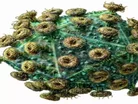The most deadly virus affecting the immune system

A lot of people including kids and adults do not understand how HIV and AIDS are related, even though they hear these two terms all the time. The human immunodeficiency virus (HIV) is one of the most serious and deadly disease in the human history. It causes a condition called acquired immunodeficiency syndrome, better known as AIDS. As Bill Clinton says, “AIDs is no longer a death sentence for those who can get the medicines. Now it’s up to the politicians to create the comprehensive strategies” to better treat the disease.”
What is HIV?
Human immunodeficiency virus is a lentivirus that causes acquired immunodeficiency syndrome (AIDS), a condition in humans which progressive failure of the immune system allows life-threatening opportunistic infections and cancers to thrive. HIV infects cells of the human immune system, and destroys or impairs their function. Infection with this virus results in the progressive deterioration of the immune system, leading to immune deficiency. The immune system is considered deficient when it can no longer fulfill its role of fighting off infection and diseases. HIV destroys a type of defense cell in the body called a CD4 helper lymphocyte. These lymphocytes are part of the body’s immune system, the defense system that fights infections. When HIV destroys these lymphocytes, the immune system becomes weak and people can get serious infections which they otherwise would not.
Symptoms of HIV infection
People who become infected with HIV may not have any symptoms for up to 10 years, but they can still pass the infection to others. After you come in contact with the virus, it can take up to 3 months for the blood test to show that you have HIV. The symptoms related to HIV are usually due to different infections in the body. The symptoms related to HIV infections includes diarrhea, fatigue, fever, frequent vaginal yeast infections, headache, mouth sores, muscle stiffness or aching, rashes of different types including seborrheic dermatitis and psoriasis, sore throat and swollen lymph glands.
What is AIDS?
AIDs stands for acquired immune deficiency syndrome and is the final stage of the infection caused by the virus called HIV or Human Immunodeficiency Virus. The virus causes severe damage to the immune system and makes people more vulnerable to infections and diseases. This susceptibility worsens as the disease progresses. The common bacteria, yeast, parasites and viruses that usually do not cause serious disease in people with healthy immune systems can turn deadly for the patients suffering from AIDS.
Symptoms of AIDS
AIDs is caused by a virus called HIV. When HIV enters the blood streams a person may become infected with it. When this happens, a person is said to be HIV positive meaning that the presence of the virus has been detected within the body. A person suffering from HIV does not necessarily have AIDs. There are many ways of contracting AIDs and the most common ways of contacting is by using a needle with infected blood and having any contact with infected blood or body fluids. There is no cure for AIDS but medical treatments can slow down the rate at which HIV weakens the immune system.
Difference between HIV and AIDs
One of the major differences between HIV and AIDs is that HIV is a virus and AIDs is the disease caused by that virus. When HIV progresses to AIDS, however, it has proved to be a universally fatal illness. Few people survive five years from the time they are diagnosed with AIDs. The experts estimate that about half the people with HIV will develop AIDS within 10 years after getting infected. One must note that every HIV positive person does not end up having AIDS, but everyone tested positive for AIDS has HIV present in the body. HIV has four stages, with the final one being AIDS. The first stage is the window. At this stage the HIV test looks for the antibodies present and not the virus. The second stage is seroconversion. At this stage, the body starts developing antibodies to fight off the HIV virus. The symptoms such as fever and flu start showing at this stage. The third stage is symptom free. At this stage, the person shows no signs of any HIV symptoms. People can be symptom free for six months to a decade or more. Not a lot of people reach the fourth stage and can live comparatively healthier for a long time. This is another major difference between HIV and AIDS. Any person who is suffering from HIV has the probability of living longer, whereas a person who is suffering from AIDS will probably die within a limited period of time.
Treatment
There is no cure for acquired immunodeficiency syndrome, but medications have been effective in fighting HIV and AIDs complications. The drug treatments help in reducing the HIV virus in the body and keep the immune system as healthy as possible and lessen the complications one may develop. Some of the drugs approved by the FDA to treat HIV and AIDS include Abacavir (Ziagen, ABC), Didanosine (Videx, dideoxyinosine, ddI), Emtricitabine (Emtriva, FTC), Lamivudine (Epivir, 3TC), Stavudine (Zerit, d4T), Tenofovir (Viread, TDF), Zalcitabine (Hivid, ddC), and Zidovudine (Retrovir, ZDV or AZT). These drugs interrupt the virus from duplicating, which may slow the spread of HIV in the body. There are many drugs now available to treat HIV infection. Some, including AZT, interfere with the virus as it tries to copy itself inside the immune system cells. Other drugs stop the virus maturing and leaving the cells.
The only way to know for sure if one is infected with HIV is to be tested. Many people infected with HIV do not have any signs and symptoms at all for many years.



